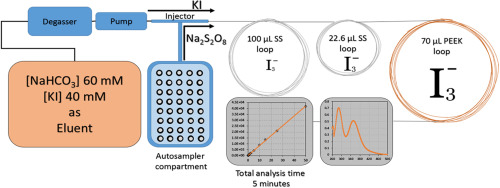Talanta ( IF 5.6 ) Pub Date : 2017-09-17 , DOI: 10.1016/j.talanta.2017.09.036 Abbas Baalbaki , Nagham Zein Eddine , Saly Jaber , Maya Amasha , Antoine Ghauch

|
Existing analytical techniques used for the quantification of persulfate (PS) in water mostly rely on polarography, reductometry or spectrophotometry. Although acceptable to a certain extent, these methods did not satisfy environmental chemists seeking rapid, reproducible and accurate quantification of PS upon the application of ISCO and AOPs technologies. Accordingly, a novel flow injection/spectroscopy analytical technique is developed via the use of an HPLC coupled to bypass capillary columns and a DAD detector. Special HPLC configuration uses concentrated KI solution as mobile phase to readily reduce PS present in the sample. The reaction takes place inside the capillary columns, under moderate pressure facilitating the production of Iodine suspension (), to yield finally the formation of the Triiodide anion () in the presence of an excess of . Triiodide absorbs at 352 nm which minimizes interferences from other organic contaminants (OCs). The method was validated by comparison to traditional PS quantification methods and tested on several environmental samples. The new method proved its superiority in terms of time requirement, labor need, material consumption, sample volume and simplicity. It eliminates the inconsistency present in other idiometric methods which is caused by the delay between the PS/ reaction and measurement. The obtained LDR extends from 0.075 to 300 mmol L−1 with a LOD of 6.6 × 10−3 mmol L−1 and a LOQ of 2.20 × 10−2 mmol L−1. The method is successfully implemented in our laboratory to rapidly and automatically monitor the variation in the concentration of PS used in different projects, which facilitates the rapid determination of the reaction stoichiometric efficiency (RSE) of the oxidation reaction, a key factor toward the optimization of the mineralization process and its sustainability.
中文翻译:

使用改进的HPLC装置快速定量水系统中的过硫酸盐
用于定量水中过硫酸盐(PS)的现有分析技术主要依靠极谱法,还原法或分光光度法。尽管在一定程度上可以接受,但是这些方法并不能满足环境化学家在应用ISCO和AOPs技术后寻求快速,可重现和准确定量PS的要求。因此,通过使用连接到旁路毛细管柱的HPLC和DAD检测器,开发了新颖的流动注射/光谱分析技术。特殊的HPLC配置使用浓KI溶液作为流动相,可轻松降低样品中存在的PS。反应在毛细管柱内进行,压力适中,有利于碘悬浮液的产生(),最终生成三碘化物阴离子() 。三碘化物在352 nm处吸收,可最大程度地减少来自其他有机污染物(OCs)的干扰。通过与传统PS定量方法进行比较验证了该方法,并在几种环境样品上进行了测试。新方法在时间要求,人工需求,材料消耗,样品量和简便性方面证明了其优越性。它消除了其他惯用法中存在的由PS / PS之间的延迟引起的不一致。 反应和 测量。所得的LDR从0.075延伸至300mmol L -1,LOD为6.6×10 -3 mmol L -1,LOQ为2.20×10 -2 mmol L -1。该方法已在我们的实验室中成功实施,可以快速自动地监测不同项目中所用PS浓度的变化,这有助于快速确定氧化反应的反应化学计量效率(RSE),这是优化SPC的关键因素。成矿过程及其可持续性。











































 京公网安备 11010802027423号
京公网安备 11010802027423号